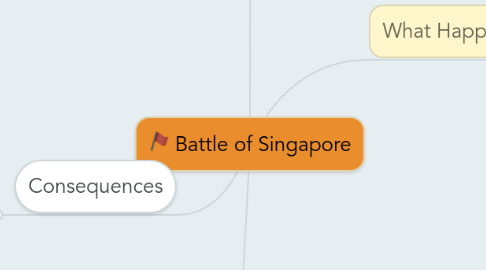
1. Consequences
1.1. The Japanese occupation of Singapore started after the British surrender. The city was renamed Syonan-to.
1.2. The Japanese sought vengeance against the Chinese and to eliminate anyone who held any anti-Japanese sentiments.
1.2.1. The other ethnic groups of Singapore—such as the Malays and Indians—were not spared either.
1.3. An Indian revolutionary Rash Behari Bose formed the Indian National Army with the help of the Japanese, who were highly successful in recruiting Indian soldiers taken prisoner.
1.4. After the Japanese surrender in 1945, Yamashita was tried by a US military commission for war crimes.
1.4.1. Like those committed by Japanese personnel not under his command in the Philippines earlier that year, but not for crimes committed by his troops in Malaya or Singapore.
1.5. Yamashita was convicted and hanged in the Philippines on 23 February 1946.
2. Parties Involved
2.1. Japanese
2.2. Allies
2.2.1. Conisted of the United Kingdom, India Malaya and Australia.
3. Causes
3.1. The Allies (British) had imposed a temporary stop of trading with Japan in response to its continued campaigns in China
3.2. Seeking alternative sources of necessary materials for its Pacific War against the Allies, the Japanese saw Singapore as a port which could be used as -
3.2.1. - a launching pad against other Allied interests in the area
3.2.2. - to consolidate the invaded area
4. What Happened?
4.1. The Japanese had invaded Malaysia
4.1.1. started the attack on Singapore by attacking the British battleship HMS Prince of Wales and the British battlecruiser HMS Repulse.
4.2. Percival incorrectly guessed the Japanese would land forces on the North East side of Singapore.
4.2.1. This was encouraged by the deliberate movement of enemy troops in this sector to deceive the British. The Japanese assaulted Sarimbun Beach.
4.3. They advanced down the Malayan peninsula overwhelming the defenses.
4.3.1. The Japanese forces also used bicycle infantry and light tanks, allowing swift movement through the jungle.
